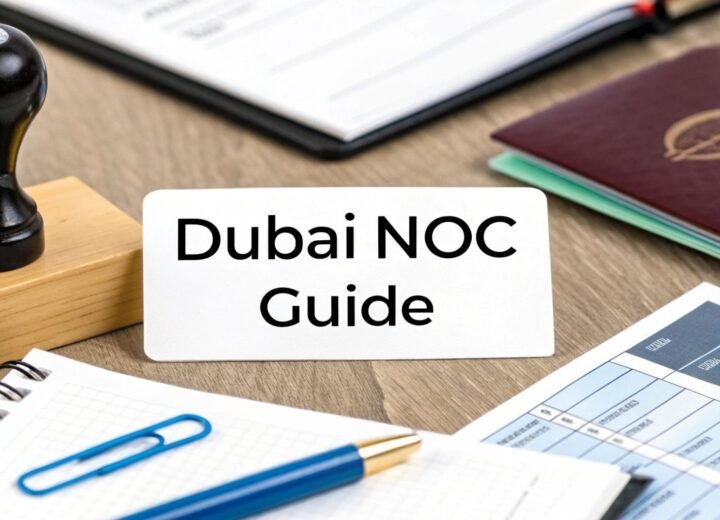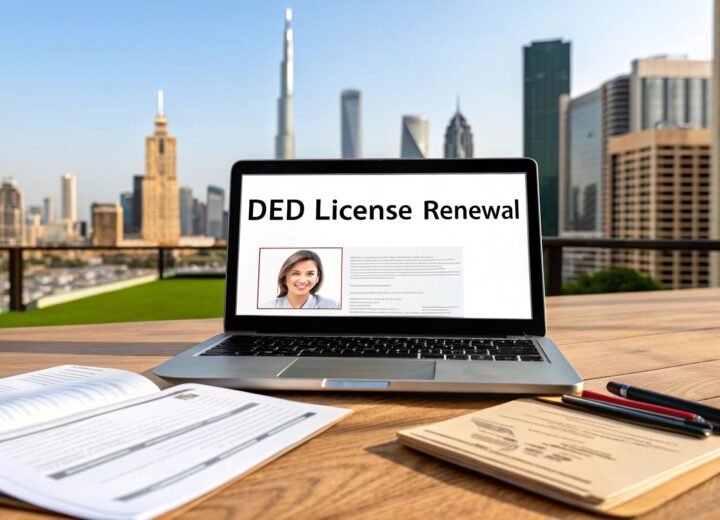Getting your Emirates ID application submitted is the first real step to unlocking life in the UAE. This card is so much more than a piece of plastic with your photo on it; it's the master key to accessing services, signing contracts, and just getting through your daily routine as a resident.
Your Essential Pass to Life in the UAE
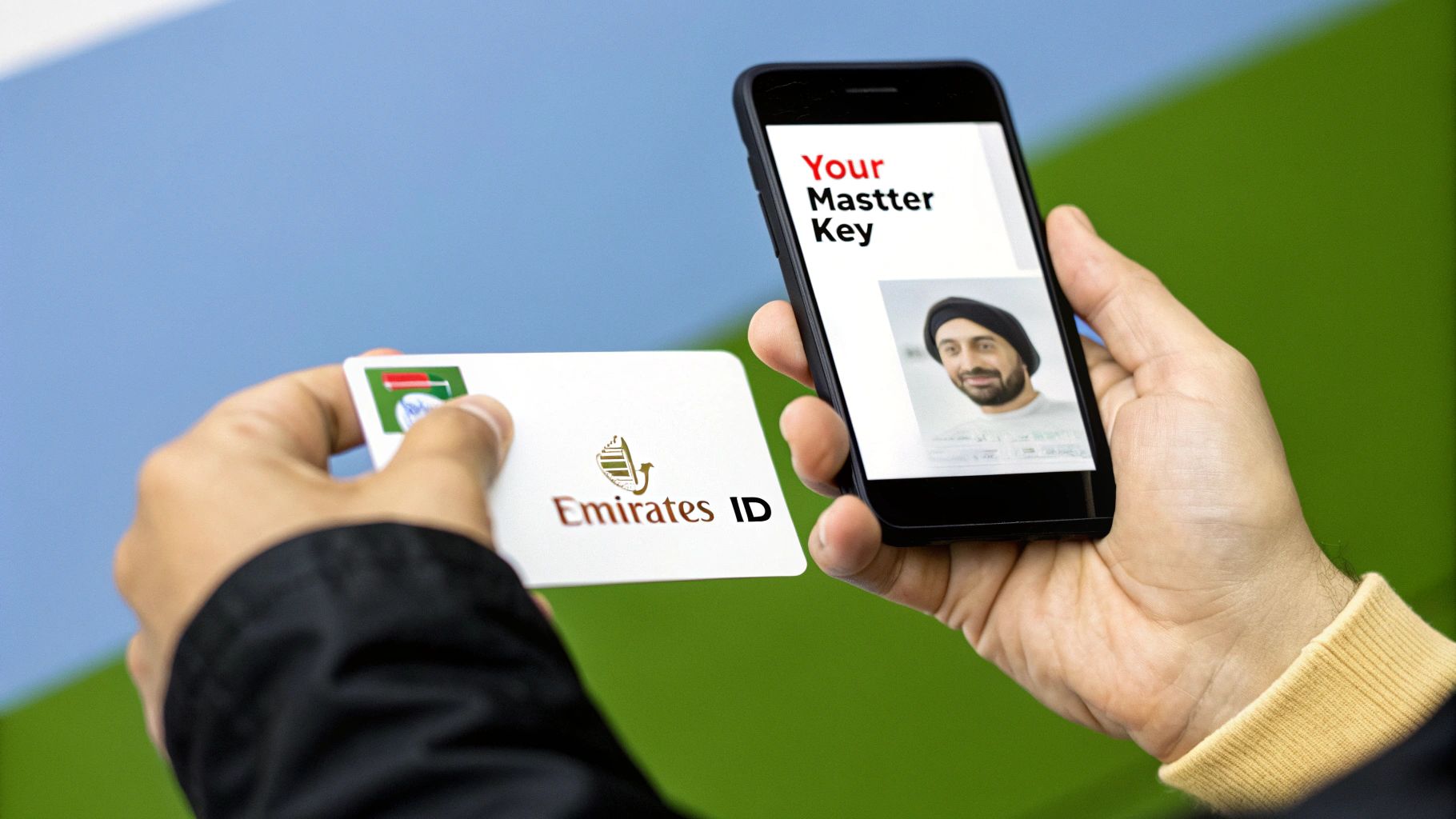
Honestly, think of the Emirates ID as the central hub for your entire life here. You simply can't function properly as a resident without it. The card is required for almost every single significant transaction you'll make, going way beyond a simple proof of identity.
From the moment you start setting up your life, you'll realise how indispensable this card is. It's the first thing you'll be asked for when tackling the fundamental tasks of moving to a new country. Without a valid Emirates ID, navigating these processes becomes incredibly frustrating, if not outright impossible.
The ID's Role in Daily Transactions
Your Emirates ID is the primary document you'll need for a huge range of essential activities. Getting these things sorted smoothly and quickly really hinges on a successful and timely application.
Here are just a few real-world examples of where it's non-negotiable:
- Financial Services: You can't open a personal or corporate bank account without a valid Emirates ID.
- Housing and Utilities: You'll need it to sign your tenancy contract (Ejari) and to connect essential services like electricity, water, and internet.
- Healthcare Access: Registering for the mandatory health insurance and getting access to medical services is tied directly to your ID.
- Mobility: It’s often required for buying a car or getting a local driving licence.
The way the Emirates ID is integrated into the country's digital infrastructure is profound. Understanding its central role makes it clear why getting the application right from the start is so critical for a seamless beginning to your residency.
Your Gateway to Digital Government Services
The card's importance goes far beyond physical transactions and deep into the digital world. It acts as your secure login to a massive network of online government and private sector services through the UAE Pass system.
The Federal Authority for Identity, Citizenship, Customs and Port Security (ICP) has reported that over 11 million users actively use their Emirates ID through the UAE Pass platform. This single login provides access to more than 5,000 digital services, which really shows how the card functions as the backbone of countless essential tasks.
This digital key simplifies everything from renewing your visa to paying fines online. For anyone looking to live or work in the UAE, getting a handle on the broader residency landscape is key, including details like the Dubai visa application process. For a complete walkthrough of the initial steps, you can also read our comprehensive guide on how to get a UAE residence visa.
Getting Your Paperwork Right the First Time
Let's be honest, a successful Emirates ID application all comes down to having your paperwork in perfect order. From my experience, missing or incorrect documents are the number one reason applications get delayed or flat-out rejected, turning what should be a simple process into a real headache.
Knowing exactly what you need before you even start can save you a world of stress. The core documents are pretty much the same for everyone, but the specific requirements can change depending on your situation. For example, the paperwork for a new employee sponsored by a mainland Dubai company is going to look a bit different from what a dependent needs to join their family in a Sharjah free zone.
The Must-Haves for Every Applicant
No matter your visa type, there are a few non-negotiable documents you'll need. Think of these as the foundation of your application file. Get these right, and you're already halfway there.
- Valid Passport: You'll need your original passport and a clear copy. The golden rule here is to ensure it has at least six months of validity left. Anything less is an immediate red flag and will likely get your application bounced.
- Passport-Sized Photograph: This is where so many people trip up. The photo has to be recent (taken within the last three months), set against a pure white background, and meet the very strict ICP size and quality specifications. Remember: no smiling and no glasses.
- Valid Entry Permit or Residence Visa: If you're a new applicant, your entry permit is essential. For those renewing, you'll need your current Emirates ID and the stamped residence visa in your passport.
A classic mistake we see all the time is applicants submitting photos that don't meet the precise background or facial expression rules. It seems like a small detail, but this simple error can bring your entire Emirates ID application to a halt, forcing you to start the whole thing over. Always double-check the photo requirements before you submit.
Documents for Your Specific Situation
Once you have the basics sorted, you'll need a few more documents to prove your specific status in the UAE. If you're an employee, this means providing an offer letter or your official employment contract from your company. This document is what formally links your application to your sponsor.
For dependents, like a spouse or child, you'll need to show attested marriage or birth certificates to prove the relationship. It’s also worth noting that certain visa categories, especially for investors or Golden Visas, might require a No Objection Certificate (NOC). You can get the full rundown on what that involves by reading our detailed article on what is an NOC in the UAE.
To keep all your documents neatly organised and easy to access, you might want to look into using an AI document management system, which can really help simplify the process.
To make things even clearer, here’s a quick-reference table that breaks down what you'll need based on your applicant type.
Required Documents by Applicant Type
| Document | New Resident (Employee) | Dependent (Spouse/Child) | Renewal |
|---|---|---|---|
| Passport (Original & Copy) | ✔️ | ✔️ | ✔️ |
| Passport-Sized Photo | ✔️ | ✔️ | ✔️ |
| Entry Permit/Visa | ✔️ (Entry Permit) | ✔️ (Entry Permit) | ✔️ (Current Visa) |
| Current Emirates ID | ❌ | ❌ | ✔️ (Original) |
| Employment Contract/Offer Letter | ✔️ | ❌ | ✔️ (If changed sponsor) |
| Attested Birth/Marriage Certificate | ❌ | ✔️ | ❌ |
| Sponsor's Passport & Visa Copy | ❌ | ✔️ | ❌ |
Having this checklist handy ensures you won't miss a single piece of paper, setting you up for a smooth and successful application from the get-go.
Submitting Your Application Like a Pro
Right, you’ve got all your documents in order. Now it's time to actually get the Emirates ID application underway.
You’ve basically got two main routes here: head over to an accredited typing centre and have them handle it, or do it yourself through the official ICP online portal. Each path has its own perks, and it really just boils down to how comfortable you feel with the whole process.
The Typing Centre Route
A lot of people, especially if it's their first time, really prefer the hands-on help they get at a typing centre. Think of these accredited offices as your middlemen; they make sure your application form is filled out perfectly and all your documents get uploaded to the government system without a hitch.
The trick is to pick a good one. Always look for a centre with solid reviews and transparent pricing so you don't get hit with any surprise fees. It can make all the difference.
Navigating the Digital Route
If you're pretty tech-savvy and don't mind filling out online forms, applying directly through the ICP portal is a solid, efficient choice. The digital form is designed to walk you through each section, but honestly, a few of the fields can be a bit tricky.
Pay very close attention here. Make sure your name is entered exactly as it appears in your passport. And then triple-check that your passport number and expiry date are spot on. A simple typo at this stage can lead to some seriously frustrating delays down the line.
The infographic below really breaks down why getting this prep work right is so vital before you kick off either submission process.
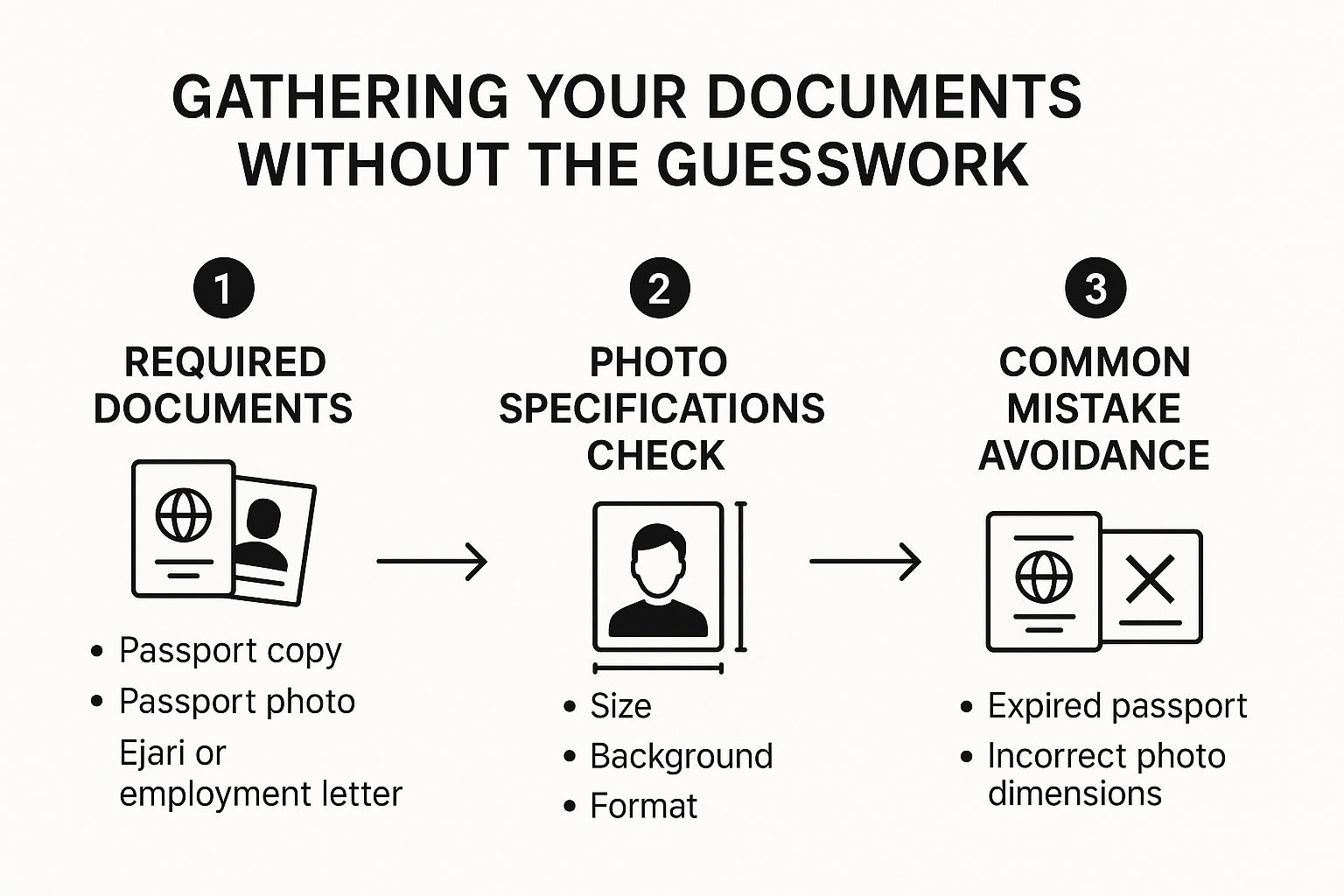
As you can see, a smooth submission—whether you're at a typing centre or doing it online—all comes back to having your ducks in a row from the very beginning.
Now, for more complicated situations, like family sponsorships or special visa types, getting some professional guidance can be a lifesaver. Whether you're applying under a Golden Visa on Property or an Investor Visa, having an expert in your corner ensures all your paperwork lines up perfectly with the specific requirements for your visa category. Our team at PRO Deskk offers Corporate PRO services to manage these submissions, taking the stress completely off your plate.
What to Expect at Your Biometrics Appointment
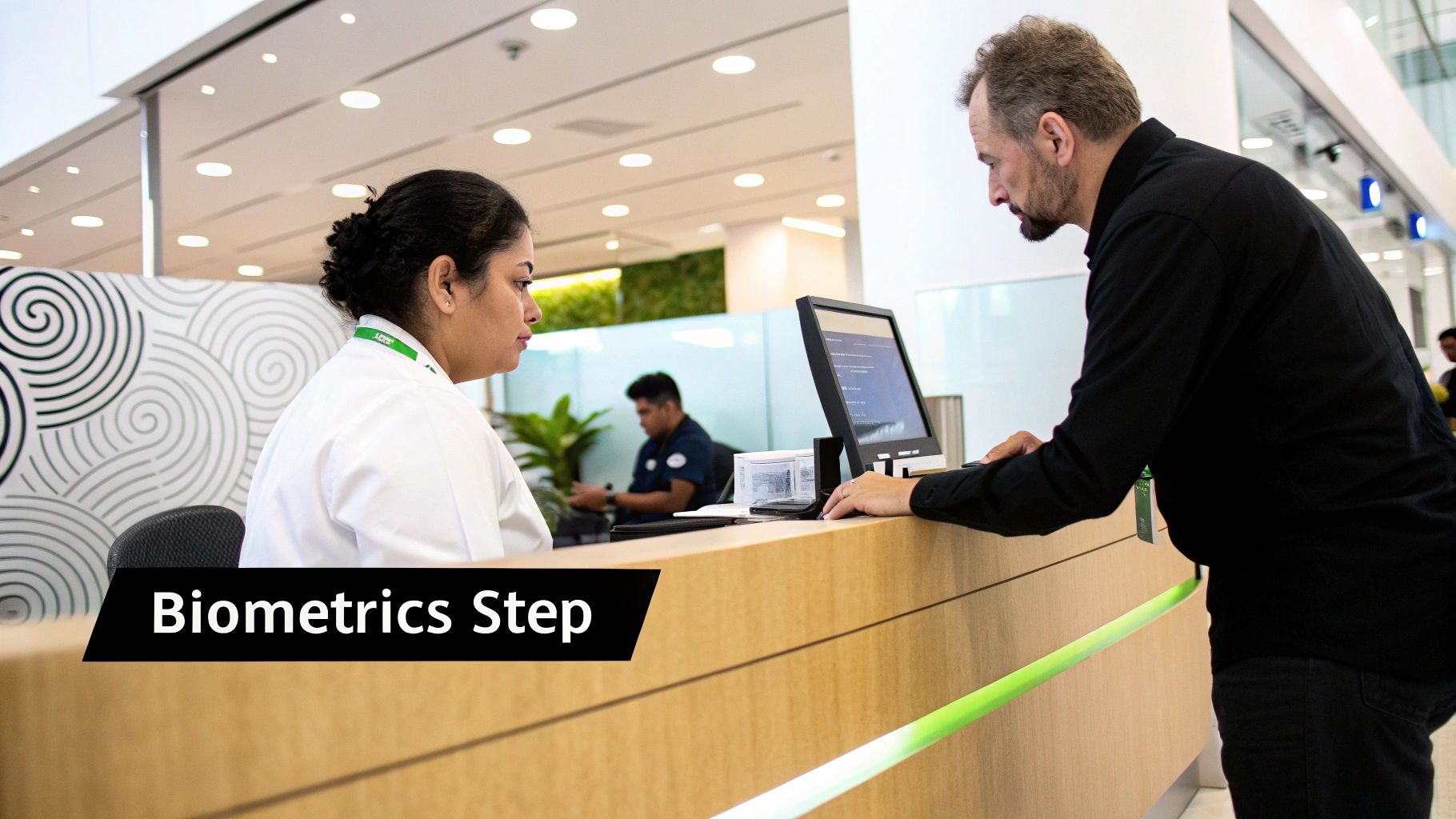
Once your Emirates ID application is submitted and gets the green light, your next stop is the biometrics appointment. This is a mandatory step in the process, and while it sounds official, it's actually a very quick and organised procedure to securely log your identification data.
You’ll get a notification to book a time slot at your nearest ICP Customer Happiness Centre after your application is processed. It's a good idea to book this as soon as you can—the popular slots tend to fill up fast.
On the day, try to arrive a little early. If you’re late, you risk losing your slot and having to go through the rescheduling process all over again, which can cause some annoying delays.
What to Bring With You
You don't need to haul in a huge stack of papers, but a few key documents are absolutely essential. Forgetting even one of these means you’ll probably be turned away.
- Original Passport: They will not accept copies. Make sure you bring the actual, valid passport you used for the application.
- Entry Permit or Current Visa: This is the document that proves your legal status in the UAE.
- Application Form Receipt: Have the printout or a digital copy of your application confirmation handy. It contains your unique application number, which they’ll need.
The most common hiccup people run into at this stage is showing up without their original passport. The staff at the service centres are very strict about this rule, so do a final check for it before you head out the door. It’ll save you a lot of hassle.
The appointment itself is really straightforward. An official will take a high-resolution digital photo for your new ID card and then electronically scan all ten of your fingerprints.
The whole thing rarely takes more than 15-20 minutes. Just listen to the instructions from the staff, and you'll be finished and one step closer to getting your new ID before you know it.
Tracking Your Application and Getting Your ID
Once you’ve finished your biometrics appointment, the waiting game begins. This can feel like the most nerve-wracking part of the whole Emirates ID application process, but thankfully, keeping an eye on your progress is pretty simple.
The Federal Authority for Identity, Citizenship, Customs and Port Security (ICP) has a reliable online portal you can use. Just head to the ICP website and find the "Check Application Status" service. You'll need to enter your application number, also known as the PRAN, which is printed on the receipt from the typing centre or in your online confirmation. This gives you a real-time look at where your ID is in the pipeline.
What Do the Status Updates Actually Mean?
The status messages can look a bit like jargon at first, but they follow a clear sequence from the moment you apply to the day the card is in your hand. Understanding them helps you know exactly what’s happening.
Here’s a quick rundown of what you’ll likely see:
- Application in Progress: This just means the authorities are doing their background checks and verifying all your details.
- Card Printing: Good news! Your application has been approved, and your physical ID card is being made.
- Card Dispatched: The card is printed and has been passed to the courier for delivery.
- Ready for Collection: Your Emirates ID has arrived at the post office or delivery centre you selected.
Here's a pro tip: Download the official ICP UAE app right after your biometrics. As soon as your application gets the final approval, a digital version of your Emirates ID pops up in the app. This is often days before the physical card arrives, and it's officially recognised everywhere.
This digital ID is a lifesaver. You can use it to open a bank account, sign up for a mobile plan, or handle other essential tasks without having to wait for the plastic card.
Typically, the whole process from your biometrics scan to having the physical card takes about 5 to 10 working days. Using the digital version in the meantime is a great way to hit the ground running.
Handling Renewals, Replacements, and Common Hurdles
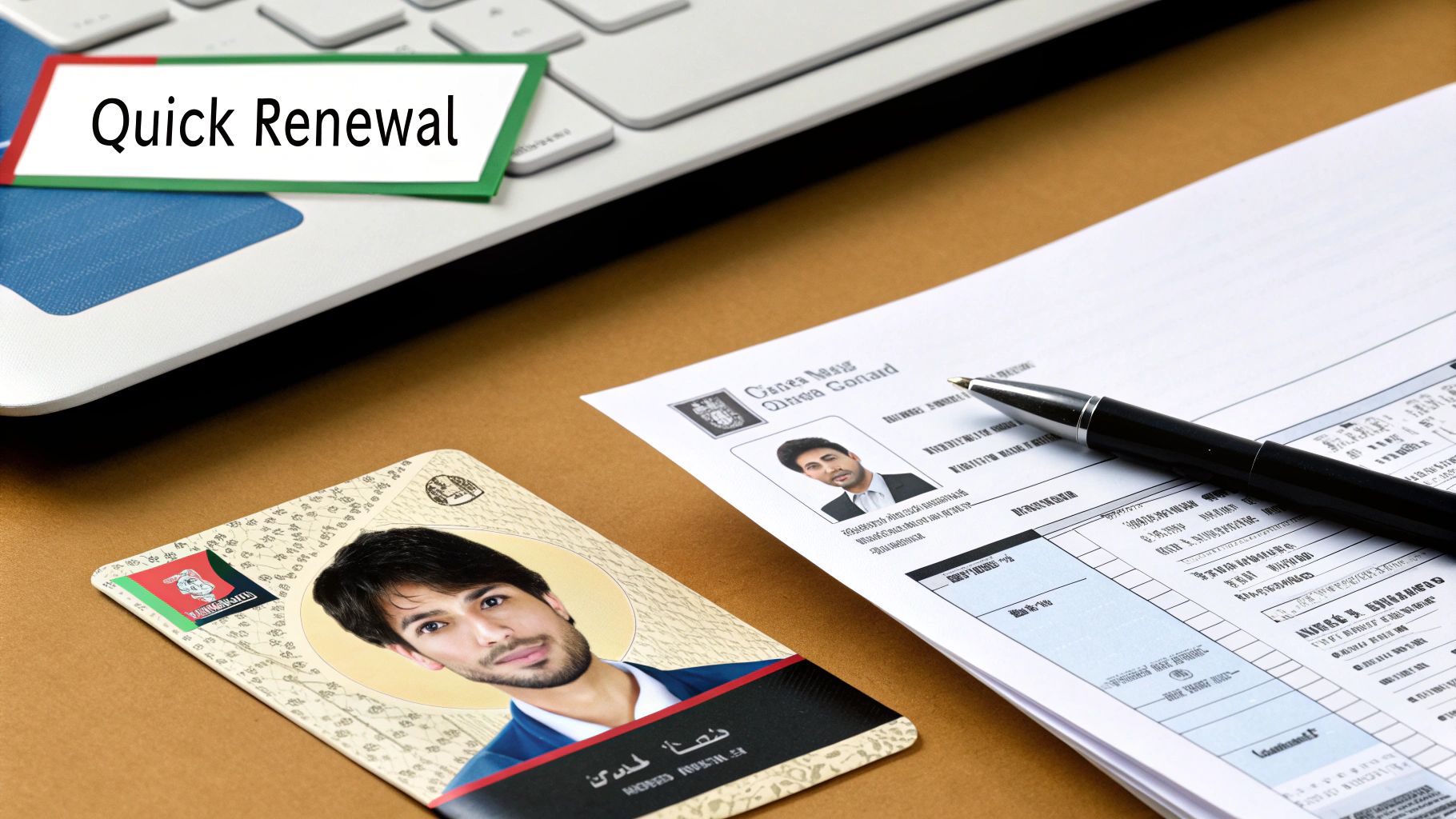
Your journey with the Emirates ID doesn't end once you have the card in your wallet. Keeping it valid is just as important, and staying on top of renewals is key to maintaining your legal residency status. I always advise clients to start the process about one month before the current card expires to avoid any last-minute stress.
Of course, life happens, and sometimes you might be out of the country when your ID is due for renewal. Recognising this common scenario, new ICP regulations now provide a one-month grace period for residents whose cards expired while they were abroad. You can get the specifics on how this updated renewal system works for those travelling internationally.
For a complete walkthrough of the entire procedure, our detailed guide on the Emirates ID renewal process covers every step you'll need to take.
When Things Go Wrong
Beyond renewals, you might run into other issues. A lost, stolen, or damaged card is a common headache. If this happens to you, the first thing you must do is report it to the ICP immediately. This allows them to deactivate the card, protecting you from potential identity misuse, and start the replacement process.
Another frequent problem is having your initial Emirates ID application rejected. More often than not, this comes down to simple, preventable mistakes that trip people up.
- Photo Errors: The number one reason for rejection is a non-compliant photograph. It absolutely must have a pure white background and meet all the other specific ICP guidelines. Don't try to cut corners here.
- Data Mismatches: Even a tiny typo in your name or passport number can bring the whole process to a halt. Any discrepancy between what's on your application and what's in your official documents will get it flagged.
The best way to avoid these frustrating delays? Meticulous proofreading. Seriously, spend an extra five minutes double-checking every single detail before you hit submit. It can save you weeks of back-and-forth with the authorities and ensure a smooth process.
If you're dealing with a complicated case or just want an expert to manage the process for you, our Corporate PRO Services are designed to handle these procedures efficiently. We make sure your ID stays valid and your residency remains secure.
Answering Your Emirates ID Questions
Even with a step-by-step guide, you're bound to have some questions pop up during the Emirates ID application process. It happens to everyone. Here are the most common queries we get from applicants, with straightforward answers to help you avoid any hiccups.
How Long Does It All Take?
From the moment you hit 'submit' on your application to holding the physical card in your hand, you're generally looking at about one to two weeks.
This timeline can shift depending on how busy the authorities are and, more importantly, how accurate your application is. The good news? A digital version of your ID pops up in the ICP app almost as soon as your biometrics appointment gets the green light.
What if My Application Gets Rejected?
First off, don't panic. If your application is sent back, the ICP will tell you exactly why. It's usually something small, like a blurry document or a typo.
The most common culprits are photos that don't meet the strict background requirements or tiny mistakes in your name or passport number. You just need to fix the specific error they've pointed out and resubmit it.
A rejection isn't a dead end; it's just a request for a correction. Find the issue the ICP mentioned, fix it carefully, and send it back through. Double-checking every single detail the second time is the key to preventing more delays.
Can I Apply Before My Visa Is Stamped?
This is a firm no. Your Emirates ID is tied directly to your residency visa, so you have to follow a specific order.
First, you get your entry permit. Then you complete the mandatory medical fitness test. Only after those two steps are done can you start the Emirates ID application. The final step—getting the residence visa sticker in your passport—often happens at the same time your ID card is being printed and prepared for delivery.
At PRO Deskk, we make complex processes simple. Our expertise is your advantage:
✅ Specialists in Mainland Company Formation in Dubai, Sharjah & Abu Dhabi
✅ Specialists in Freezone Company Formation across the UAE
✅ Specialists in Golden Visa on Property and Investor Visa
✅ Specialists in Corporate PRO Services and Attestation Services
✅ 24/7 Support Service – Always here when you need us
✅ Cost-Effective Business Setup Solutions tailored to your needs
✅ Enjoy UAE Tax Benefits for International Entrepreneurs
📞 Call Us Now: +971-54-4710034
💬 WhatsApp Us Today for a Free Consultation

